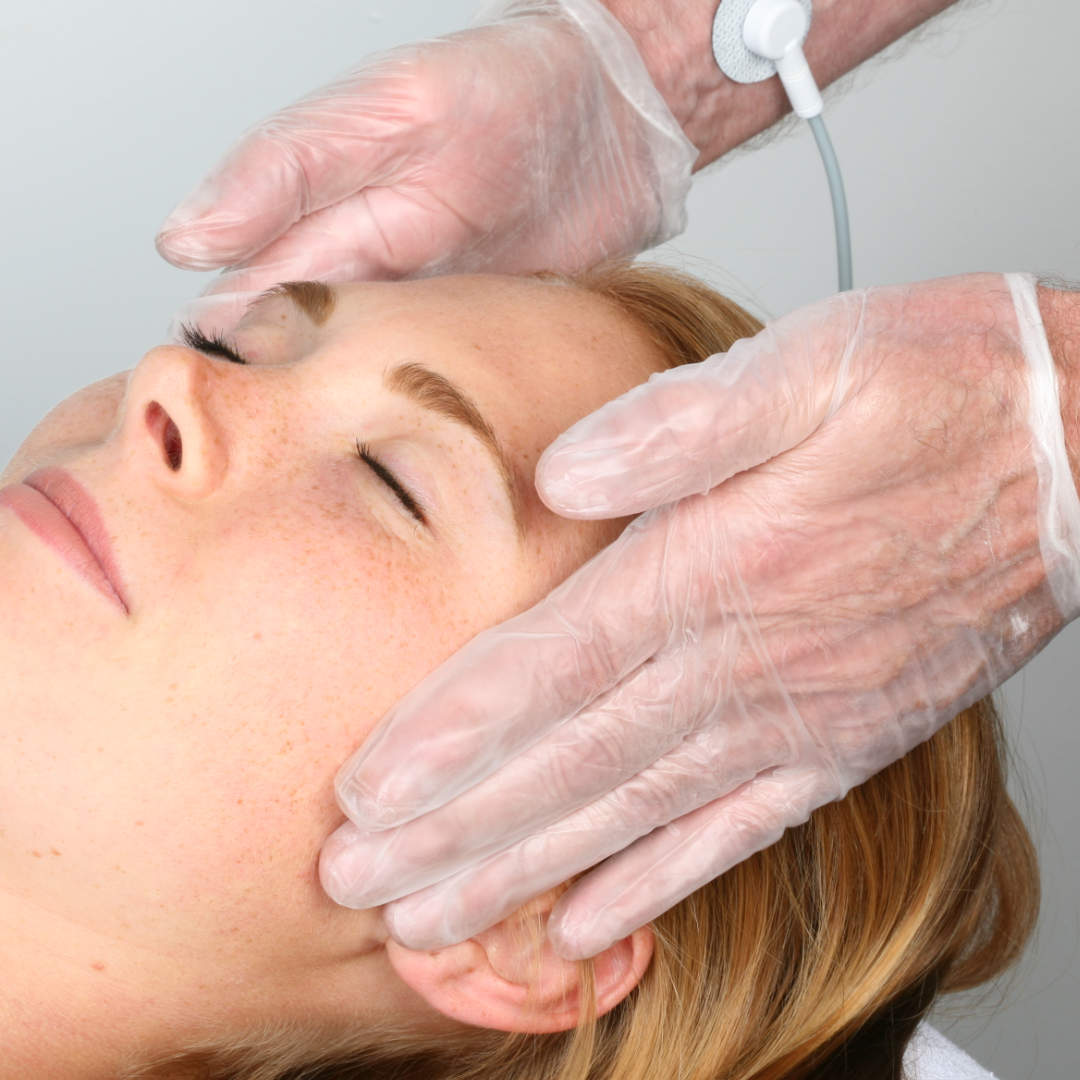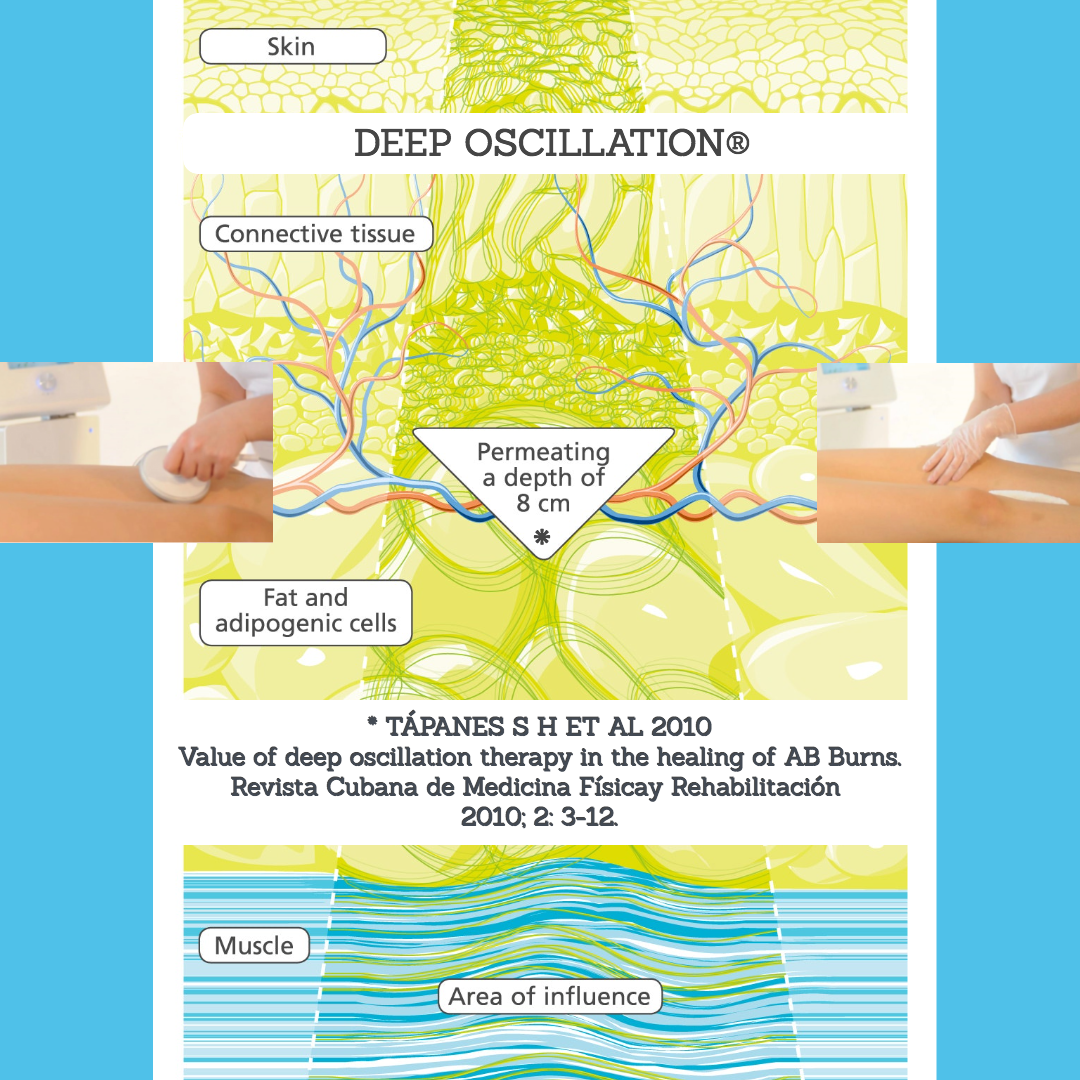Deep Oscillation in The Management of Head and Neck Lymphoedema following Cancer Surgery
"I am a 42 year old Emergency medicine doctor and mum of two young children. In the Summer of 2020, a sore patch on my tongue was diagnosed as squamous cell carcinoma and I had brutal treatment involving surgery followed by chemo and radiotherapy. After finishing treatment I was keen to do as much as possible to get well and return to work but had many side effects to contend with, one of which was lymphoedema to my face and neck. This was due to the combination of removal of my lymph nodes on one side plus the radiotherapy.
As well as making me look different, the swelling affected my neck mobility, making it stiff with a decreased range of movement. It also impacted on my eating and speech.
I sought treatment on the NHS but was told there wasn’t any local service for head and neck patients and was also given the impression that this was just “normal post operative swelling” and wasn’t anything to be concerned about. In doing my own extensive research it became apparent that Lymphoedema, particularly in head and neck patients, is an area where medical knowledge falls short. In the UK provision of rehab is patchy at best and varies depending on where you live. Friends with the same diagnosis in the US received both acknowledgement of it as an issue and much more intensive treatment.

DEEP OSCILLATION is applied through vinyl gloves or applicator (which also enable self treatment). Clinically proven effects include lymphatic drainage, fibrosis break down and oedema reduction thus improving mobility. [1-25]
* Subjective improvements are also noted in this article
I came across the Physiopod site and thought that deep oscillation therapy would be worth a try; luckily I was able to locate a qualified therapist not too far from where I live. Sue Hansard is fantastic: she has many years of experience treating Lymphoedema in head and neck patients and told me she’d had some great results with deep oscillation.
The treatment itself is painless and in fact actively relaxing, and to my astonishment I could see a visible difference to the swelling from the very first session. I started with twice weekly treatments and my Lymphoedema improved significantly – * my jawline came back and my facial symmetry improved; my speech became clearer, my swallow was easier and my neck mobility returned meaning I could sleep on my front and swim front crawl again!
Sue taught me a full range of techniques including self massage and compression but I will continue to visit for deep oscillation at regular intervals as it’s made such a difference to me. I only wish it was more widely available, so that others could benefit as I have."
What are the types of tongue cancer?
Information with thanks to Cancer Research UK
The most common type of tongue cancer is squamous cell carcinoma (SCC). Squamous cells are the flat, skin like cells that cover the lining of the mouth, nose, larynx, thyroid and throat. Squamous cell carcinoma is the name for a cancer that starts in these cells.
What are the symptoms of tongue cancer?
The symptoms of tongue cancer might include:
- a red or white patch on the tongue that won't go away
- a sore throat that doesn't go away
- a sore spot (ulcer) or lump on the tongue that doesn't go away
- pain when swallowing
- numbness in the mouth that won't go away
- unexplained bleeding from the tongue (that's not caused by biting your tongue or other injury)
- pain in the ear (rare)
It's important to remember that these symptoms might be due to a less serious medical condition. But it's best to check symptoms with your GP just to make sure.
Swelling of the face or neck (Lymphoedema)
Information with thanks to Macmillan Cancer Support
After surgery for head and neck cancer, it is common to have some swelling in your face or neck. This usually goes away within a few weeks. You are at greater risk of developing long-term swelling if: you had an operation to remove lymph nodes from your neck, you had radiotherapy after surgery. The swelling happens because the lymphatic system, which normally drains fluid away, is not working properly. This is called Lymphoedema. Lymphoedema can also affect tissues inside the neck, such as the throat or larynx (voice box). This can cause problems with speaking, swallowing of breathing. Lymphoedema may be worse in the morning and improve as the day goes on. We have more information about Lymphoedema, how to reduce your risk of developing it and how it is managed.
ABOUT DEEP OSCILLATION®

In contrast to externally applied, mechanical forms of therapy, (e.g. vibration), the therapy effect of DEEP OSCILLATION® takes place in the tissue itself and works through the entire depth of the tissue layers (skin, connective tissue, subcutaneous fat, muscles, blood and lymph vessels)
DEEP OSCILLATION® helps in speeding up and improving wound healing processes. Through the oedema-reducing and anti inflammatory effect, the local metabolic elimination and alimentation is improved in all tissue layers, whereby tissue regeneration and wound closure are encouraged on many levels. This is documented by the significant improvement in planimetric and biochemical parameters of the wound healing. Because of the non-invasive, non-traumatic, gentle nature of this therapy, very early possibilities of application are possible following injury and from Day One post operatively. Chronic conditions can also be worked upon with effective results.
References
- Atashkhoei S., Fakhari S. (2016): Management of Breast Cancer Related Lymphoedema. Crescent Journal of Medical and Biological Sciences 3 (4), 111-112.
- Brenke R. - Therapie des Lymphödems EHK 2021; 70: 138-144 DOI - 10.1055/a-1477-817
- Brenke R., Freund R., Strößenreuther RHK (2010): Adjuvant physical therapy for lymphedema and selected comorbidities of the musculoskeletal system. In: Földi M., Földi E. (Ed.): Textbook Lymphology. 7th ed., Elsevier GmbH, 508.
- Brenke R., Siems W. (1996): Adjuvant Therapy for Lymphedema. Lymphol 20, 25-29.
- Flemming D. (2016): The technique of deep oscillation. Lymph self-help, 22-23.
- Gasbarro V., Bartoletti R., Tsolaki E., Sileno S., Agnati M., Coen M., Conti M., Bertaccini C. (2006): Ruolo dell'oscillazione profonda (Hivamat® 200) nel trattamento fisico del linfedema degli arti. La medicina estetica 30 (4), 473-478. English title: The role of deep oscillation therapy (Hivamat® 200) in the physical treatment of the lymphoedema of the limbs.
- GDL (Society of German-speaking Lymphologists) u. DGL (German Society of Lymphology) (2017): AWMF-S2k Guideline "Diagnosis and Treatment of Lymphedema" (AWMF Reg. No. 058-001).
- Jahr S, Schoppe B, Reisshauer A. Effect of treatment with low-intensity and extremely low-frequency electrostatic fields (Deep Oscillation) on breast tissue and pain in patients with secondary breast lymphoedema. J Rehabil Med. 2008 Aug;40(8):645-50. doi: 10.2340/16501977-0225. PMID: 19020698.
- J of IMAB 2016 Jul-Sep;22(3):1248-1252 Improving the quality of life through effects of treatment with low intensity, extremely low frequency electrostatic field with DEEP OSCILLATION® in patients with breast cancer with secondary lymphedema to patients treated with standard lymph equipment. Atanas Petkov1 Corresponding Autor, Yana Kashilska2, Angel Uchikov1, Dean Batzelov3,
- Jui Chu Y. (2017): HIVAMAT 200. In: Jui Chu Y. (Ed.): What Can Physical Therapy Do After Breast Cancer Surgery. CARE, 187-188. German translation: What can physical therapy do after breast cancer surgery.
- Kraus R. (2014): Intensive lymphatic drainage through deep oscillation. LYMPH & Health 2, 6-8.
- Lipiska A., Opuchlik A. (2014): Fizycoterapia w onkologii. In: ?liwi?ski Z., Siero? A. (Ed.): Wielka Fizjoterapia. Elsevier GmbH, 289-294. English title: Physical Therapy in Oncology.
- Mortimer P., Levine G. (2019): Let's Talk Lymphoedema, The Essential Guide to Everything You Need To Know
- Reisshauer A., Pögel S. (2010): Treatment of Secondary Arm Lymphodema in Breast Cancer. Gynecol. prax. 34, 489-499.
- Reißhauer A., Auler S., Bieringer S., year S. (2009): physical decongestive therapy. In: Reißhauer A., Auler S., Bieringer S., year S. (Ed.): Compendium of the lymphological compression supply. Federal School of Orthopedic Technology, 42-57.
- Seidl H. (2006): The HIVAMAT procedure in the context of decongestive therapy. In: Bringezu G., Schreiner O. (Ed.): Textbook of Entstauungstherapie. 2nd ed., Springer Medizinverlag, 245-250.
- Schingale F.-J. (2006): Head, breast and genital lymphedema - a special challenge for the lymphatic therapist. vasomed 1, 30-31.
- Talbot C. (2011): Lymphoedema Support Network periodical 'Lymphline', Spring Issue, Deep Oscillation for lymphoedema
- Teo I., Coulborn A., Munnock DA (2016): Use of the HIVAMAT® 200 with manual lymphatic drainage in the management of lower limb lymphoedema and lipoedema. Journal of Lymphoedema 11 (1), 49-53
- Theys S., Deltombe T., Legrand C., Hanson P. (2008): Manual Drainage with or without DEEP OSCILLATION® in Lower Extremity Oedema. J Rehabil Med Suppl 47, 62.
- Kraus R. (2014): Intensive lymphatic drainage through deep oscillation. LYMPH & Health 2, 6-8.
- Talbot C. (2011): Lymphoedema Support Network periodical 'Lymphline', Spring Issue, Deep Oscillation for lymphoedema

